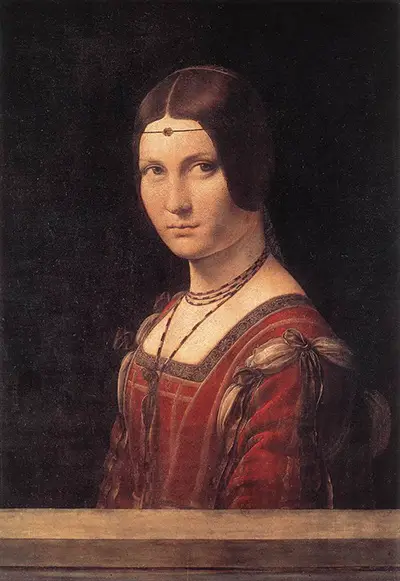It currently hangs in the Louvre and it is usually categorised as being a prime example of High Renaissance art.
The dark background of the painting is a distinctive feature of many of Da Vinci's works of art, and it is echoed in the dark backgrounds of later Baroque works from the seventeenth century.
La Belle Ferronniere depicts a white woman with black hair, wearing a red dress that is characteristic of the time.
Her accessories, including a small band across her forehead, are simple and unassuming. However, they help to lend the woman an air of elegance.
It is hard to parse precisely what the expression of the woman denotes as she looks slightly slantwise towards the viewer.
Is she sleepy? Reproachful? Seductive? The ambiguity of her expression has led several art critics to link the appearance of La Belle Ferronniere to what is perhaps Da Vinci's most famous painting: the Mona Lisa, with her enigmatic smile. Compare this artwork with Raphael's La Fornarina, for example.
The phrase La Belle Ferronniere literally means 'the beautiful ironmonger'. However, in this context 'ferronniere' refers to the headband that the woman in the painting is wearing across her forehead. This headband was popularly known at the time as a 'ferronniere'.
It was a very common feature of Lombard fashions in the late fifteenth century. This painting is also sometimes known as 'Portrait of an Unknown Woman'.
However, there has been speculation about the subject of La Belle Ferronniere. Most theories gravitate towards the idea that this painting represents Lucrezia Crivelli, who was the mistress of the then Duke of Aragon.
Some art critics, however, believe that the painting depicted Isabella of Aragon herself.
Another important thing to note about La Belle Ferronniere is the links that it has with another painting by Leonardo: Lady with an Ermine.
Like La Belle Ferronniere, Lady with an Ermine has also been simply known by the title of 'Portrait of an Unknown Woman'. Lady with an Ermine depicts a vivacious lady holding a bright white ermine. Like La Belle Ferronniere, it has a bold dark background that throws the central figure into sharp relief.
Lady with an Ermine is thought to be a depiction of Cecilia Gallerani, who was the mistress of the Duke of Aragon before Lucrezia Crivelli became his mistress.
Further cementing the links between these two paintings is the fact that Cecilia Gallerani was once thought to be the subject of La Belle Ferronniere, whilst Lucrezia Crivelli has also been thought to be the subject of Lady with an Ermine.
It is likely that the Duke of Aragon commissioned both of these paintings of his mistresses.
Finally, La Belle Ferronniere may not in fact have been painted by Leonardo Da Vinci himself. Art critics are still debating about this matter. It may have been painted by one of Leonardo's acolytes, for example.
La Belle Ferronniere was particularly popular in the nineteenth century, when numerous artists attempted to copy either the general style of the painting or the painting itself.
It is not the first painting by Da Vinci to have been made the subject of a forgery. Indeed, many of this artist's paintings have had dramatic histories - the Mona Lisa itself was shockingly stolen and then returned after an extensive man hunt.


